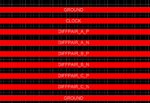rbmaze
Newbie level 3
I am redesigning a flex PCB based on a design that has three differential pairs and a clock between two ground traces. The closest type of transmission line I can relate this to is a coplanar waveguide. I have attached an image of what it looks like. All the traces are the same width and spacing (0.15mm). These signals need to be impedance matched and I have other signal integrity concerns. Signals up to 1GHz will be traveling up to 6 inches like this.
I believe the differential impedances should all be 90 ohms. Is that even possible with this type of layout? It is a 2-layer PCB but there are no ground planes and there are other signals on the bottom layer.
I greatly appreciate any help!

I believe the differential impedances should all be 90 ohms. Is that even possible with this type of layout? It is a 2-layer PCB but there are no ground planes and there are other signals on the bottom layer.
I greatly appreciate any help!



